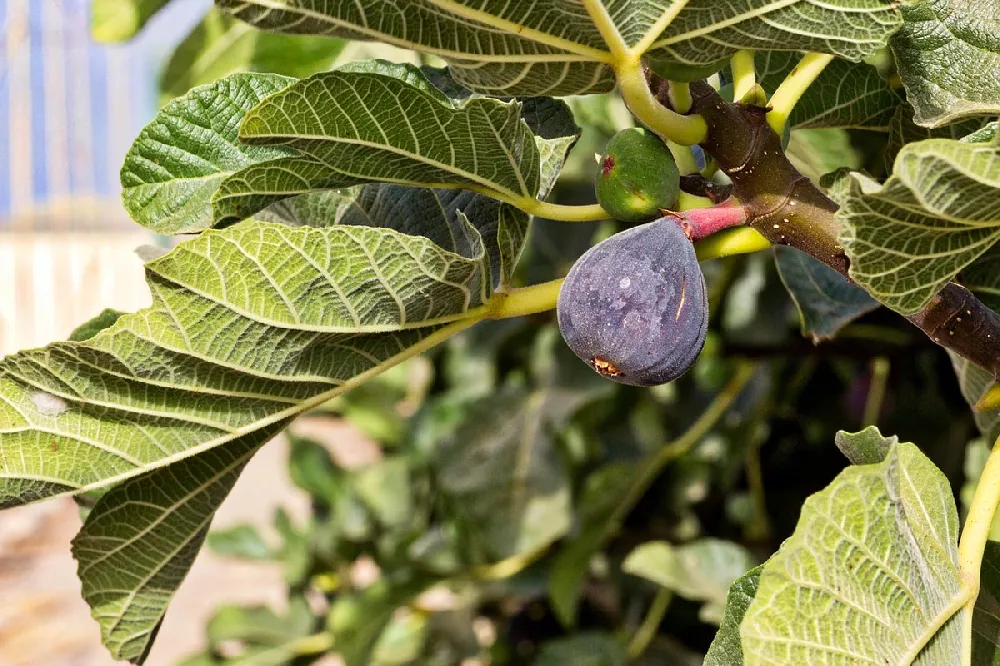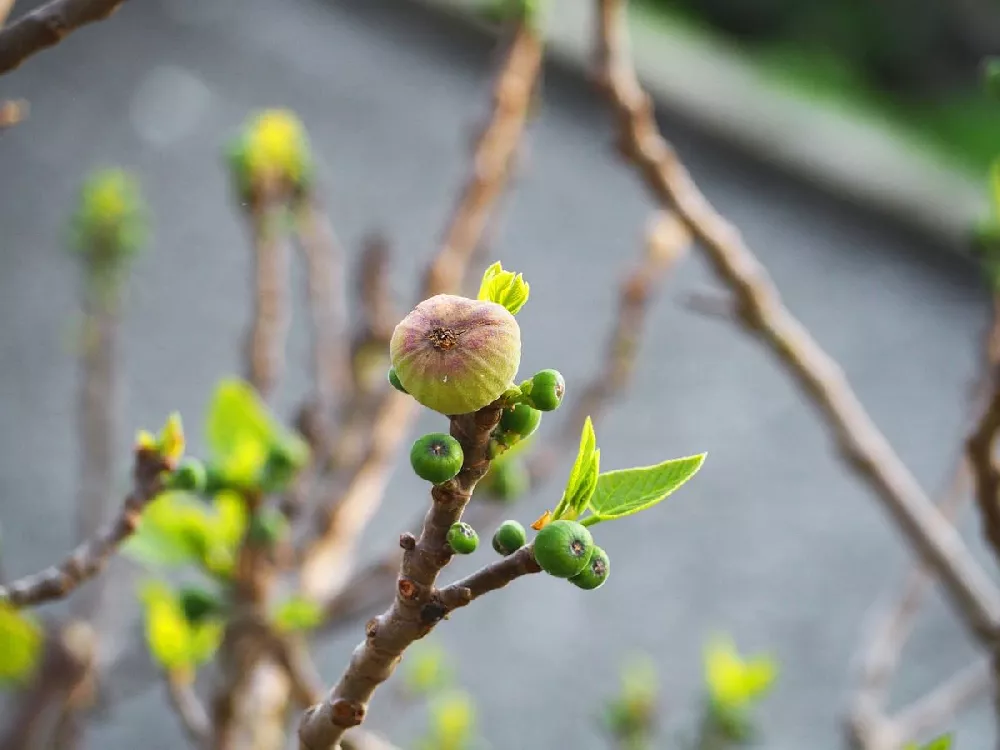- Home >
- Edible Plants >
- Black Mission Fig Tree
Black Mission Fig Tree for Sale - Buying & Growing Guide
- Ships in 1-2 days
- 1-Year Warranty Eligible
- Pots or accessories are not included unless specified in the product options.
Shipping Details:
Products shipped through FastGrowingTrees.com. Once your order is shipped, you’ll receive an email with a tracking number and estimated delivery date. Most orders will ship immediately.
Fig trees often do not get the respect that they deserve. Their fruit is sweeter than most, with an incredible texture that makes them good for both fresh eating and cooking. The trees themselves are attractive and easy to grow. And the Black Mission fig tree, Dorstenia ficus 'Black Mission,' is one of the best examples of this species. It requires little in the way of care, not needing a lot of pruning or fertilizing, and it produces not one but two harvests in an average year. The trees, which can be grown as multi-stemmed bushes, can reach 30 feet high, but they also adapt well to growing in containers for those in northern regions. Aside from the fruit, they make an excellent specimen plant in informal gardens, with large, deep-green, attractive leaves. Here are a few more reasons to consider adding one or more to your garden:
- Black Mission fig trees are resistant to deer but attractive to songbirds.
- Once established, they need little supplemental watering and are fairly drought-resistant.
- Their height is easily controlled when grown in a container.
Plant Care
Sunlight

The Black Mission fig tree does best in partial to full sunlight — four or more hours of direct light a day.
Watering
When newly planted, water every few days. Once it's established, water whenever the soil 2 inches down is dry.
Fertilizing

Fertilize with a balanced, slow-release product designed for fruit trees regularly through the growing season.
Planting and Care
Planting instructions
Site your Black Mission fig tree in well-draining soil, giving it adequate space for its potential width of 15 to 30 feet when mature. The site should get at least four hours of sunlight a day and not be under any overhead wires. Unpot your tree, and tease out any encircling roots, which can slowly girdle the tree and kill it. Dig a hole that’s as deep as the root ball and twice as wide. Throw a few handfuls of well-rotted compost or manure into the hole, and place the tree on top of it. Holding the tree steady and upright, fill in around its roots with topsoil, tamping down as you go to eliminate air pockets. Water thoroughly. Apply a 2- to 3-inch layer of an organic mulch, such as bark chips, around the tree’s root zone to conserve moisture and hinder weed growth.
Watering and nutrients
Until you see robust new growth, water your newly planted Black Mission fig tree every few days. Then taper back to once-a-week waterings for the rest of the first year. After that, monitor the tree’s water needs by checking the soil about 2 inches below the surface. If it’s dry, give the tree some supplemental watering. Fertilize your fig tree with a balanced, slow-release fertilizer designed for fruit trees throughout the growing season, tapering back in winter when the tree is dormant.
Pollination
Figs are monoecious, meaning that a single tree has both male and female reproductive organs. Thus, you are able to harvest figs even if you only have a single tree — unlike fruits such as apples and pears. Figs are unusual in that they do not have visible flowers; the flowering apparatus is inside the immature fruit, where it is fertilized by tiny wasps called fig wasps.
Pruning
Prune your fig tree in late winter, before the buds develop and while the tree is still dormant. Prune out any dead, broken, or diseased branches as well as any that are rubbing against each other. Also look for branches that seem weak or secondary, and cut them back to the nearest main branch. Prune off any suckers that appear around the base of the trunk as well. Your tree will need less pruning as it ages, but when it is young, you can prune it for shape and to open up the canopy to light and air.
Pests, diseases, and animals
Figs are occasionally preyed upon by several types of nematode, which can impede growth. There are also several fig-specific insect pests, including the fig beetle and fig scale insect. Diseases that may attack figs include alternaria rot, a fungal disease that is best treated by picking fruit before it is overripe, and botrytis limb blight, which can be treated with a fungicide. If you have an active small mammal population in your region, you may find creatures such as squirrels and rabbits attracted to the figs.
Harvesting
It takes a little finesse to know when a fig is ripe, and often the best way to tell is to pick one and bite into it. Figs do not continue to ripen after being picked, so you need to choose the right moment to cut them off the tree. Look for figs that are hanging downward on stems that have slightly wilted — as opposed to fruit that is still held on a stiff stem perpendicular to the ground. A ripe fig will also be softer than an unripe one. Pick them gently; they bruise easily. tore your figs in a cool location.
Achieving maximum results
Black Mission fig trees are hardy down to 10 degrees Fahrenheit, which means they can be grown outside in most of the southern U.S., California, and Pacific Northwest. If you live north of USDA hardiness zone 7, however, you can still grow your fig tree in a container. Bring your tree inside in the winter when it is dormant and leave it in a basement or garage until spring. Remember to water your indoor fig tree occasionally. Other than that, it won’t need a great deal of care until your temperatures rise in spring and you are able to bring it back outside.
FAQs
How long will it be before I get a harvest from my fig tree?
Generally, you can expect a first, light harvest anytime from two to six years after planting. The Black Mission fig tree is unusual in that you should get two harvests a year from it: a large crop in spring and a smaller crop in late summer or early fall.
Can I eat a fig right off the tree?
Yes. There are few tastes as satisfying as a sweet, lush, fresh fig eaten right off the tree. You can also use these figs in cooking, in any recipe that calls for figs or other sweet fruits. For example, figs can be used to make excellent jams and chutneys as well as pies and other baked goods. There's also the classic British "figgy pudding," which makes an excellent dessert.
How is a Black Mission fig tree best used in the garden?
Fig trees are often grown as multi-stemmed large bushes or small trees, and they have the handsome silhouette and attractive leaves to allow them to be used as a specimen tree, standing alone in a front or back yard. Their full canopy means they can serve as a loose and informal hedge or windbreak, and a grouping of three or more in a spot that gets partial sun can be quite appealing when placed behind smaller shrubs or perennials.










